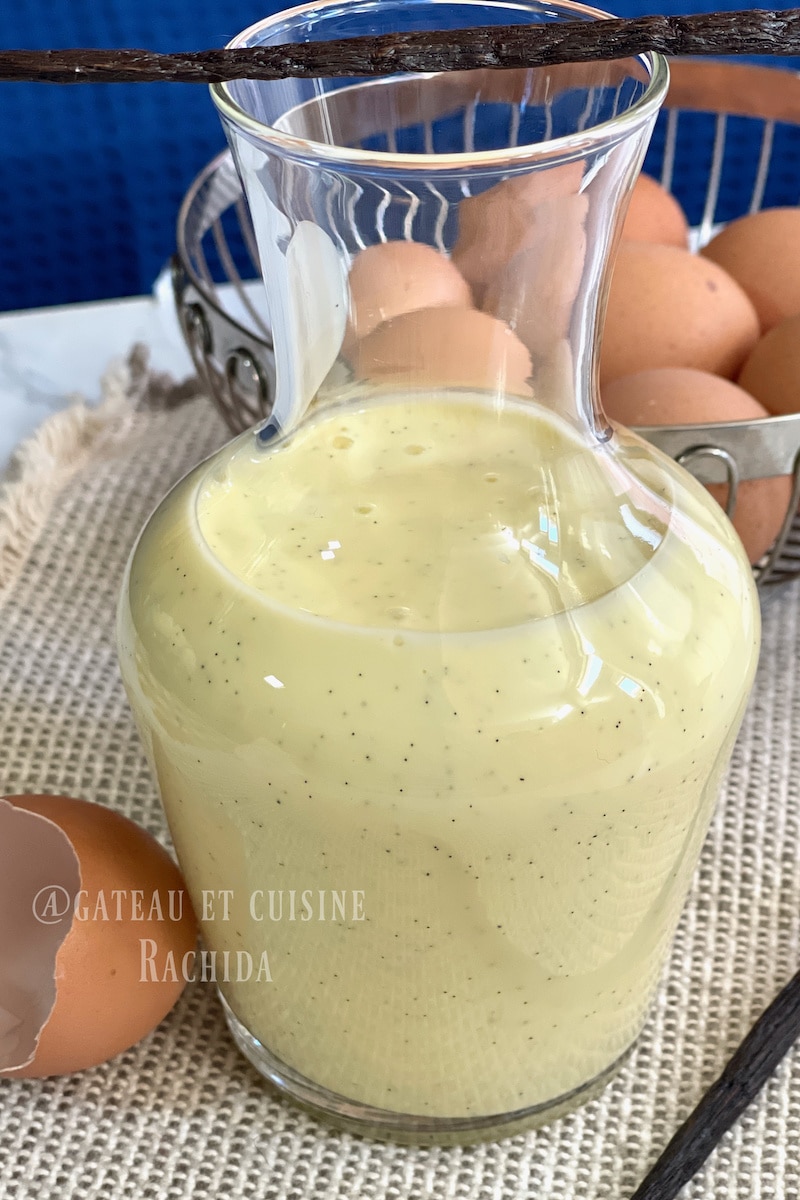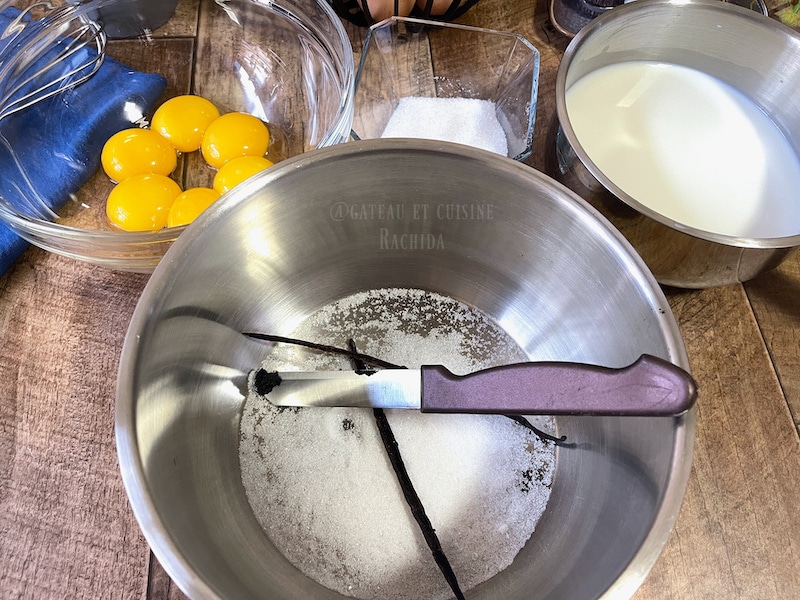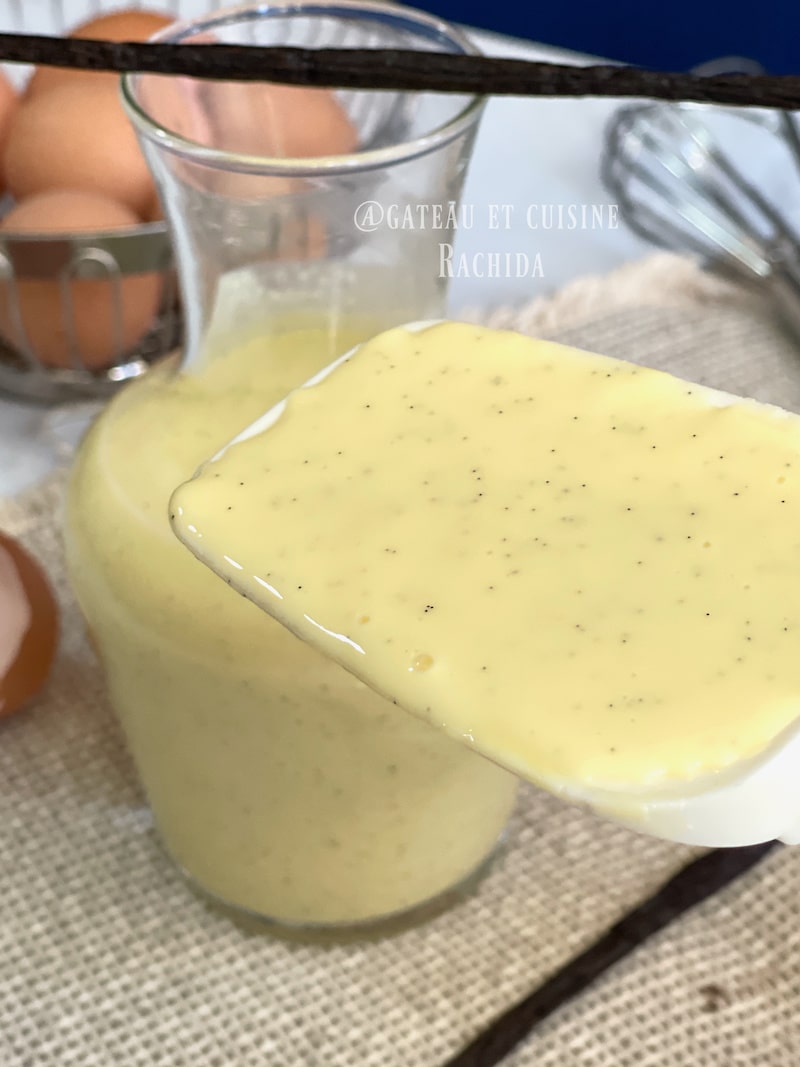Crème anglaise “Custard sauce” is an essential basic recipe in French pastry. It is made with milk, sugar, and egg yolks, often flavored with vanilla. Crème anglaise means “English cream”. It is frequently served as an accompaniment to desserts such as cakes, tarts, or fruits.
A recipe used in many pastries, and its preparation requires a particular technique to achieve a smooth and creamy texture. It is a cream that is now widely used in international cuisine. It has become a must for dessert lovers.

Easy custard “crème anglaise”
Crème Anglaise “Vanilla Custard” is a basic pastry recipe, a creamy sauce more liquid than pastry cream “crème pâtissière”. It’s one of the recipes you’ll need to master if you love baking. This cream is used in many recipes, such as Bavarian cream and ice creams, among others.
It is renowned for making tasty, airy chocolate mousses, as in my 3 chocolate mousse cake. Buttercream made with crème anglaise is more flavorful and lighter.
It is essential for making many other recipes. I think it’s the base cream I’ve used the most in my recipes. You can find it in the raspberry charlotte cake and in many others desserts.
If you didn’t know, custard is the main base for making good, creamy ice cream!

Table of Contents
What is custard used for?
It is used to
- Ice cream
- Bavarian cream
- Light buttercream
- Light diplomat cream
- Chocolate mousse
- Cremeux etc…
To accompany
- Floating island
- Brownie
- Chocolate fondant
- Piece of pie
- Fruits etc…

Details on the ingredients
Whole milk, semi-skimmed, or a 50/50 mix of milk and heavy cream.
Egg yolks : Only egg yolks are used to make a custard. Depending on the recipe, 4, 5, or 6 egg yolks are used for 1/2 liter of milk. The more egg yolks the custard contains, the richer and creamier it will be. Most recipes use 4 egg yolks. I prefer to use 6 to optimize its creaminess.
Sugar : The quantity can vary from 85 to 125 g ( (3 to 4.41 oz) sugar according to taste.
Vanilla bean, vanilla sugar or pure vanilla extract

Tips for a Perfect Crème Anglaise
Should You Whisk Egg Yolks and Sugar Until Pale?
We’ve all gotten into the habit of whisking egg yolks and sugar until pale, but this isn’t the best approach for custards.
Whisking creates a foam that can be quite troublesome during cooking. Fortunately, it disappears and indicates that the custard is ready.
To avoid this, do not whisk the egg yolks and sugar too much.
Straining the Cream
Once you have made the cream, you need to strain it through a fine sieve to remove any milk particles.
Blending for Smoothness
If the texture isn’t to your liking, you can give it a quick blend with an immersion blender.
This will give you a silky smooth and luscious custard!
Cooking : A Key Point for Success
Crème anglaise is a very simple recipe, but perfecting it is another matter. Mastering the cooking process is the most important aspect. You need to cook the cream just enough for it to coat the back of a spoon, known as “cuisson à la nappe,*” but not too much to avoid coagulating the egg yolks.
The cooking should be done over medium heat, stirring in a figure-eight motion to slightly thicken the mixture. This technique is called “vanner la crème.” It is crucial to avoid bringing the crème anglaise to a boil. Using a thermometer can help monitor this step. The temperature should not exceed 85°C (185°F).
I never use a thermometer by adopting the simple trick below when the foam that forms begins to disappear, the end of cooking is near.
| * Cooking “à la nappe” involves continuously stirring the cream with a spatula until it coats the back of the spatula. To check if it’s done, dip the spatula in the cream and run your finger across it to draw a line. The line should be well-defined. |

The secret to a Smooth and Successful Crème Anglaise
Everyone wants to achieve a thick, creamy custard. This is ideal for drizzling over a nice piece of cake or brownie. A custard that is too thin would just soak the cake, which isn’t very appetizing.
To achieve a very smooth and creamy custard, you need to use a technique to thicken the cream for a longer period. Thickening means heating it longer; however, the risk is that the cream might boil and curdle.
The secret to prolonging the correct thickening temperature without worry, until you get a super-smooth custard, is to play with the heat.
Remove the saucepan from the heat several times, stirring constantly. Lift the saucepan over the heat for a few seconds or to one side, return to the heat, remove and continue until the cream coats the spatula well.
By applying this gesture, you maintain the right thickening temperature without letting it exceed 85°C (185°F). If you are using a thermometer, remove the 83°C ( 181°F) cream from the heat. The temperature will rise slightly off the heat.

Preparation steps
NB: Find details of ingredients in the recipe card that you can print below.
1. Scrape the seeds from the split vanilla pod.
2. In a saucepan, heat the milk with one-third of the sugar, the scraped seeds, and the vanilla bean. Heat without bringing to a boil. You can cover the saucepan to prevent the vanilla flavor from evaporating (optional).
3. Remove from heat and let infuse for about twenty minutes.
4. Meanwhile, whisk the egg yolks with the remaining sugar until pale.
5. Reheat the milk, removing it from the heat just before boiling.
6. Pour a little hot milk over the egg mixture through a strainer to temper it. Stir constantly to prevent the eggs from cooking. You can pour in all the milk. The strainer will catch the milk skin and the vanilla bean.
7. Pour everything back into the saucepan and bring to medium heat.

Blanch the egg yolks and sugar and pour over the boiling milk.
8. Mix, stirring constantly with a spatula until the cream coats the spatula (be careful not to let it boil). A finger swiped across it should leave a visible line.
9. If you have a thermometer, remove from heat at 83-85°C (181-185°F).
10. Strain the custard into a container, being careful to collect all the vanilla seeds.
11. Place in the refrigerator, stirring occasionally to cool it quickly. You can cover it with plastic wrap directly on the surface until ready to use. This prevents a skin from forming on top.

Baked custard
How to fix a split custard
If, despite your best efforts, your custard has split, don’t panic, all is not lost. Your savior in this situation is the immersion blender. By blending the custard thoroughly, you’ll refine and smooth it out. Say goodbye to those tiny clumps of coagulated eggs.
To make it even smoother, pass it through a fine-mesh sieve. If you don’t have an immersion blender, don’t worry, a regular blender can do the job.
An accessible solution for everyone is to pour the custard into a bottle, seal it, and shake it vigorously, just like you would with a cocktail shaker. Then strain it through a fine sieve.

Storage
Once the vanilla crème anglaise is ready, pour it into a dish and stir it occasionally to cool it down. Store it in an airtight container, covering it with plastic wrap directly on the surface to prevent a skin from forming on top. You can transfer it to a bottle and refrigerate it for up to 24 hours, or freeze it for up to 3 months.
When ready to use, thaw it slowly in the refrigerator for a few hours. Once thawed, you can transfer it to a bottle and shake it vigorously to restore its creaminess.

Foolproof Crème Anglaise Recipe ( Classic Vanilla Custard Sauce )
INGREDIENTS
- 500 ml milk ( 16.91 fl oz )
- 6 extra-large egg yolks
- 100 g sugar ( 3.53 oz )
- 1 vanilla bean or 1 1/2 teaspoons pure vanilla extract
PREPARATION
- Scrape the seeds from the split vanilla pod.
- In a saucepan, heat the milk with one-third of the sugar, the scraped seeds, and the vanilla bean. Heat without bringing to a boil. You can cover the saucepan to prevent the vanilla flavor from evaporating (optional).
- Remove from heat and let infuse for about twenty minutes.
- Meanwhile, whisk the egg yolks with the remaining sugar until pale.
- Reheat the milk, removing it from the heat just before boiling.
- Pour a little hot milk over the egg mixture through a strainer to temper it. Stir constantly to prevent the eggs from cooking. You can pour in all the milk. The strainer will catch the milk skin and the vanilla bean.
- Pour everything back into the saucepan and bring to medium heat.
- Blanch the egg yolks and sugar and pour over the boiling milk.
- Mix, stirring constantly with a spatula until the cream coats the spatula (be careful not to let it boil). A finger swiped across it should leave a visible line.
- If you have a thermometer, remove from heat at 83-85°C (181-185°F).
- Strain the custard into a container, being careful to collect all the vanilla seeds.
- Place in the refrigerator, stirring occasionally to cool it quickly. You can cover it with plastic wrap directly on the surface until ready to use. This prevents a skin from forming on top.
You’ll achieve a smooth, semi-liquid custard with zero flaws! You’ll no longer encounter any issues in making this essential custard in pastry.
 Thank you for visiting my blog and your comments.
Thank you for visiting my blog and your comments.
easy recipe, basic recipe, vanilla, ice cream, egg yolks, desserts
